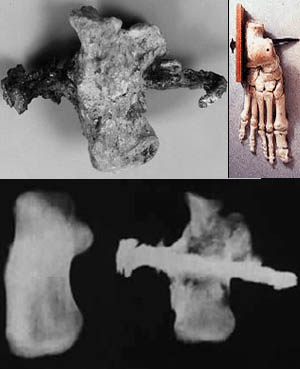퀴즈:
예수께서 박히신 못의 크기는 얼마나 됐을까?
답: 약 18cm. |
|
|

|
Yehohanan ben Hagkol's(A.D. 7-70) heel bone pierced
with a piece of spike. This man was crucified with knees flexed.
못으로 찔린 요한난 벤 하콜의 발뒤꿈치
뼈(7-70년). 이 사람은 무릎이 구부린 채 십자가에 처형되었다. .
Unique
Jerusalem Exhibit Testifies To Crucifixion
유일한 예루살렘 전시물 십자가처형을
증거하다
By
Julie Stahl
CNS Jerusalem Bureau Chief
21 April, 2000
JERUSALEM, Israel (CNSNews.com) -- The Israel Museum in Jerusalem has on display
the only archeological evidence in the world of the type of crucifixion
that would have taken place during the time of Jesus.
예루살렘에 있는 이스라엘 박물관은 예수의 시대에
있었을 십자가 처형형태에 관한 세계에서 유일한 고고학적 증거를 전시해
놓고 있다.
Found in a burial tomb
in Jerusalem, the heel bone of a young man from the time of Jesus
is still pierced with the iron nail that would have held him to
a cross.
(1968년 6월) 예루살렘에 있는 한 (4개의 굴 무덤 가운데) 무덤에서(Scopus
산이 가까운 예루살렘 북쪽) 발견되었는데(15개의 석회암 유골함에서
35명의 유골 발견), 예수와 동시대의 인물인 한 젊은이의 발뒤꿈치 뼈에는
그를 십자가에 매달았을 철 못이 여전히 박혀 있다.
Christians and others usually think of crucifixion as the cruel
and humiliating punishment meted out to Jesus, whom the Bible records
was crucified by the Romans near Jerusalem, with criminals killed
in a similar manner on either side of him.
그리스도인들과
다른 사람들은 십자가처형을 예수에게 내린 잔인하고 굴욕적인 처벌로
보통 생각하고 있다. 예수는, 성경 기록에 의하면, 예루살렘 근교에서
로마인들에 의해서, 예수의 양편에서 비슷한 방식으로 처형된 범죄자들과
함께 십자가에 못박혔다.
Crucifixion
was the punishment allotted to common criminals and others who fell
out of favor with the Romans who ruled Judea at the time. Thousands
of Jews were crucified by the Romans around the city walls of Jerusalem.
십자가처형은 일반 범죄자들과 당시
유대지방을 지배했던 로마인들에게 은혜를 입지 못했던 다른 사람들에게
내린 처벌이었다. 수천명의 유대인들이 예루살렘 성벽주변에서 로마인들에게
십자가에 처형당했다.
But David
Mevorah, co-curator of the "Cradle of Christianity" Exhibit
at the Israel Museum, says although crucifixion was a "common
punishment" used by the Romans, "nowhere [has there been]
found evidence from this practice."
그러나
이스라엘 박물관의 "기독교 발상지" 전시관의 공동 관리자인
데이비드 메보라는 십자가처형이 로마인들에 의해서 사용된 "흔한
처벌"이었지만, "아무 곳에서도 이 처형에 관한 증거를 얻지
못했었다"고 말한다.
Mevorah
told CNSNews.com the nail-pierced heel bone was found in a burial
tomb in Jerusalem in an ossuary, or receptacle for bones of the
dead.
메보라는 CNSNews.com에 말하기를,
못이 통과된 발뒤꿈치 뼈는 예루살렘에 있는 한 무덤 유골함 혹은 죽은
자의 뼈를 담는 용기에서 발견되었다고 했다.
Burial in an ossuary was the Jewish custom for only two centuries
- from 1 B.C. to 1 A.D. Bones were collected one year after death
and buried together in an ornamental box.
유골함
장례는 단지 두 세기 즉 주전 1세기부터 주후 1세기 동안에만 사용된
유대인의 관습이었다. 뼈들은 죽은지 일 년 후에 수습되었고, 장식상자속에
함께 보관되었다.
The family tombs,
Mevorah said, were inscribed with the name of the deceased in Hebrew,
Aramaic and Greek.
메보라는 말하기를,
가족 무덤들에는 고인의 이름을 히브리어, 아람어, 헬라어로 새겼다고
했다.
He said crucifixion was carried
out in different forms, with victims either tied or nailed to a
wooden beam.
그는 말하기를, 십자가처형은
다른 형태들로 수행되었는데, 나무형틀에 죄수를 묶거나 못박았다고
했다.
Asked why there are not more
archeological relics from crucifixions, Mevorah said one assumption
was that people through the ages had collected nails used in crucifixion
as amulets.
십자가처형과 관련된 유품들이
왜 더 이상 고고학적으로 발견되지 않는가를 묻자, 메보라는 말하기를,
한 가지 추정은 사람들이 수 세기에 걸쳐 십자가처형에 사용된 못들을
부적으로 수집하였다는 것이라고 했다.
Thus, he said, the heel bone now on display was the "only surviving
example of crucifixion."
그래서,
그는 말하기를, 현재 전시되고 있는 발뒤꿈치 뼈가 "십자가처형의
예로 남은 유일한 것"이라고 했다.
Experts know that this man was crucified at the time of Jesus. They
know he was a Jew of 24-25 years, but they do not know his crime
or why he was crucified.
전문가들은
이 사람이 예수 시대에 십자가에 처형되었다는 것을 안다. 그들은 그가
24-25세의 유대인이었다는 것을 안다. 그러나 그들은 그의 죄가 무엇이었으며,
왜 처형되었는가를 알지 못한다.
One thing they do know, however, is something faithful Christians
already believe.
그럼에도 불구하고,
한 가지 그들이 정말 아는 것은 충실한 그리스도인들이 이미 믿고 있는
무엇이다.
"We are sure it
was not Jesus," Mevorah said, noting the family tomb was inscribed
with the name "Yehohanan, son of Hagkol."
메보라는 그것이 "요한난 벤 하콜"이란 이름이
새겨진 가족 무덤이었다는 점을 지적하면서 "우리는 그것이 예수가
아니었다는 것을 확신한다"고 말했다.
|